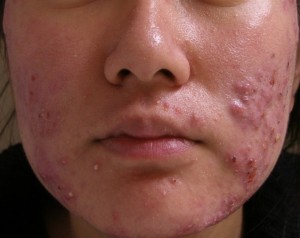Acne is one of the most common skin conditions in the United States. It can look like red bumps, pus bumps, blackheads, whiteheads, and even cysts. Acne is caused by a combination of bacteria, hormones, and clogged pores, and both environmental and genetic factors may play a role as well. It can occur on the face, back, chest, shoulders, and other places, and sometimes leaves permanent scars behind. Recent studies show that people who have acne have higher risks of depression than people without it, and it can have a profound impact on a person’s quality of life.

Many patients are surprised to learn that acne can occur at any age, from newborn to older adult. Both men and women get acne, and many people have no signs of acne until middle adulthood.
There are many options for treatment of acne, and the choice of treatment depends on what type of acne lesions you have, your skin type (dry, oily, sensitive, etc), where on your body your acne is, how much it bothers you, and other factors such as your other medications and medical history. You and your doctor will meet to discuss your type of skin and your type of acne, and to make a treatment plan together. Usually you will be given a follow up appointment a few months later to review your progress and how well you are tolerating your treatment.
